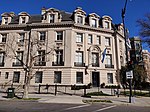Whittemore House (Washington, D.C.)
Clubhouses on the National Register of Historic Places in Washington, D.C.Dupont CircleHistoric house museums in Washington, D.C.Houses completed in 1894Houses on the National Register of Historic Places in Washington, D.C. ... and 7 more
Individually listed contributing properties to historic districts on the National Register in Washington, D.C.Modernist architecture in Washington, D.C.NRHP infobox with nocatShingle Style architecture in Washington, D.C.Shingle Style housesWomen's club buildingsWomen in Washington, D.C.

Whittemore House (also known as the Walter D. Wilcox House and the John C. Weeks House) is an historic building located at 1526 New Hampshire Avenue, N.W., in the Dupont Circle neighborhood of Washington, D.C. The former private residence, whose previous occupants include a musician, several politicians, and a mountain explorer, now serves as a historic house museum and headquarters of the Woman's National Democratic Club (WNDC).
Excerpt from the Wikipedia article Whittemore House (Washington, D.C.) (License: CC BY-SA 3.0, Authors, Images).Whittemore House (Washington, D.C.)
New Hampshire Avenue Northwest, Washington
Geographical coordinates (GPS) Address External links Nearby Places Show on map
Geographical coordinates (GPS)
| Latitude | Longitude |
|---|---|
| N 38.910691666667 ° | E -77.042466666667 ° |
Address
Whittemore House
New Hampshire Avenue Northwest 1526
20009 Washington
District of Columbia, United States
Open on Google Maps







